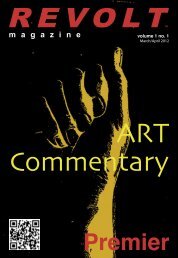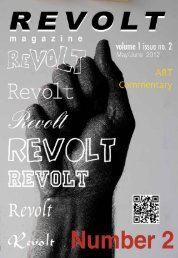Download PDF Version Revolt Magazine, Volume 1 Issue No.4
Download PDF Version Revolt Magazine, Volume 1 Issue No.4
Download PDF Version Revolt Magazine, Volume 1 Issue No.4
Create successful ePaper yourself
Turn your PDF publications into a flip-book with our unique Google optimized e-Paper software.
initiatives aimed at fixing everyday issues faced by<br />
American citizens, ranging from the environment,<br />
to women’s rights, to illegal drugs. The American<br />
media, however, has failed to keep up with this shift<br />
in emphasis. Publications continue to focus on the<br />
superficial, banal and demeaning over the political<br />
and charitable when discussing our First Lady. The<br />
result of this discourse is a constantly backfiring<br />
attempt to limit the feminine domain and return to<br />
an era of repression, and a sexual stereotype, that<br />
no longer exists.<br />
For this reason, Michelle Obama represents<br />
a perfect storm of political and social media<br />
commentary. As a woman in the public eye, she<br />
inspires a shallow, thoughtless dialog that has<br />
surrounded the feminine sphere for far too long in<br />
this country. Due to the color of her skin, she has<br />
unwittingly unleashed this undercurrent of intense<br />
racism, hatred, and at it’s core, fear, that has been<br />
masquerading through the media under the guise<br />
of political discourse and criticism. Michelle Obama<br />
is by no means the first First Lady to receive such<br />
intense public scrutiny, especially on a physical<br />
and sartorial level. Jacqueline Kennedy Onasis<br />
continues to be remembered to this day for her<br />
contributions to fashion and style, if nothing else.<br />
But when Barack Obama was first inaugurated into<br />
office, the Michelle media frenzy hit a fever pitch<br />
which has sustained itself for the past five years and<br />
will surely remain intact well beyond the completion<br />
of his second term in office. In addition to the<br />
relatively standard trivialization of the First Lady’s<br />
appearance and activities, the comments against<br />
Michelle Obama, specifically, seem to have taken on<br />
a distinctly different tone and bitterness than they<br />
have with First Ladies of the past, such as Laura<br />
Bush or Hillary Clinton.<br />
Of course, other First Ladies have been vilified by<br />
the media and had their public lives intensely, and<br />
inappropriately, put on display. But never before has<br />
a First Lady’s allegiance to her country, the size and<br />
shape of her body, or her day-to-day decisions been<br />
so intensely analyzed and attacked as Mrs. Obama’s.<br />
The problems with the type of language the media<br />
uses when discussing any woman, but in particular<br />
Michelle, are myriad. This type of insensitive,<br />
objectifying discussion undermines the authority<br />
and respect deserving of a woman in her public and<br />
political position, as well as setting back the agenda<br />
of equality, and inviting some remarkably racist, and<br />
completely out-of-line commentary. When people in<br />
political office or on national television speak about<br />
a woman of power, such as Michelle Obama, in this<br />
type of condescending, accusatory language, it<br />
gives the rest of America permission to follow suit.<br />
The claims against Michelle Obama range from<br />
attempting to appropriate the plight of black, single<br />
motherhood into her persona, to anti-patriotism,<br />
elitist spending habits and allegiances with the<br />
Black Power Movement.<br />
As Barack Obama’s term has progressed, the articles<br />
about Michelle Obama have tended to increasingly<br />
feature style over substance. In an article for The<br />
Economist in 2009, Adrian Wooldridge wrote that<br />
most new stories about the first lady, “were almost<br />
entirely devoted to fluff.” Every fashion magazine<br />
and website in America has run at least one piece<br />
on how to attain the First Lady’s amazing wardrobe;<br />
that is if they don’t already have an entire section<br />
dedicated exclusively to her daily outfit choices.<br />
Proving Wooldrige’s point, in 2009, CNN ran a<br />
segment on “How to get Michelle Obama’s toned<br />
arms.” But, as the piece points out, not everyone is<br />
a fan of the First Lady’s muscular biceps. The article<br />
quotes Boston Herald columnist Lauren Beckham<br />
Falcone who wrote to Obama, saying, “It's February.<br />
Going sleeveless in subzero temperature is just<br />
showing off. All due respect." Clearly there was no<br />
respect intended here. Would these same journalists<br />
be ballsy enough to walk up to any shoulder-bearing<br />
stranger on the street and tell them to stop showing<br />
off and cover up? What is it about Michelle Obama’s<br />
husband’s choice in profession that makes her<br />
arms and body a permissible subject of critique on<br />
a national level?<br />
And don’t think the average American woman’s<br />
personal struggle with the First Lady’s bare arms has<br />
diminished with time! Joyce Purnick, in an article for<br />
the New York Times “Style” section in 2012, wrote,<br />
“I HAD expected to keep mum about my problem<br />
with Michelle Obama until after the election, but my<br />
frustration has gotten the better of<br />
Photo courtesy of The White House.<br />
me. I can’t contain it any longer. I refer not to her<br />
politics, but to her arms -- her bare, toned, elegant<br />
arms. Enough!” According to Purnick, the first lady<br />
has made it “unacceptable for women to appear<br />
in public with covered arms.” Because, clearly,<br />
Michelle is not only the first famous woman to ever<br />
wear sleeveless clothing, but also, a dictator of<br />
sleeve lengths for women across America. Purnick<br />
concludes her article by pointing out that Michelle<br />
will turn 49 in January, suggesting, “Could it be time<br />
for her at least to begin to ponder setting a new<br />
fashion trend? Here’s a thought. Maybe she could<br />
take a cue from her husband and, in a bipartisan<br />
gesture, adopt Ann Romney’s preference for elbowlength<br />
sleeves and red taffeta. Or not.” I think the<br />
crucial take away from that sentence is “Or not.”<br />
This quote suggests that woman of a certain age,<br />
specifically, women of a certain age and public<br />
profile, should not be able to dress as they please.<br />
They should be ashamed of their bodies and of<br />
the effect they have on American woman clearly<br />
suffering from body issues of their own. Secondly, it<br />
implies that the most politicized opinion a First Lady<br />
should have is in the realm of fashion (where she<br />
can make a “bipartisan gesture” of her own), while<br />
the heavy thinking and legislature should be left to<br />
her wiser, more powerful husband.<br />
Lucky for all the tabloids, as the buff arms stories<br />
began to grow stale, Obama was inaugurated into<br />
office for his second term, and the First Lady had<br />
some exciting new changes of her own planned.<br />
According to Joselyn Noveck, a writer for the AP,<br />
“the president started it.” She’s referring, of course,<br />
to the media’s new, unbridled obsession with<br />
Michelle Obama’s bangs. According to Noveck,<br />
media outlets around the world are completely<br />
justified in talking exclusively about a First Lady’s<br />
haircut because of a husband’s admiration for his<br />
wife. Obama’s comment was clearly intended as a<br />
joke, considering he referred to the bangs as "the<br />
most significant event of this [inaugural] weekend."<br />
Despite the transparent flippancy of his statement,<br />
this quote was repeatedly taken out of context and<br />
used to justify a whirlwind of bang commentary and<br />
speculation. The Bangs even spawned their own<br />
Twitter account, which sends out thought-provoking<br />
tweets such as, "Just got a text from Hillary Clinton's<br />
side-part.” In a 2012 piece for The Washington Post,<br />
Rahiel Tesfamariam wrote, “Since the beginning of<br />
the president's term, there's been an ever-present<br />
demand to "publicly dissect" [Michelle Obama] and<br />
examine why she dresses the way she dresses, says<br />
what she says, and behaves the way she does.” The<br />
public is not satisfied until each of her decisions has<br />
been broken down and analyzed in order to suss out<br />
and reveal her presumed secret motivations behind<br />
every act. Even down to something as simple as a<br />
choice in hairstyle is suspected to have nefarious or<br />
manipulative motives.<br />
On December 28, 2012 in an article by Cathy Horyn<br />
for The New York Times, Valerie Steele, the director<br />
and chief curator of the Museum at FIT, commented,<br />
“Oddly, fashion, which has tended to be treated<br />
with extreme suspicion in American history, has<br />
not caused political problems for her.” It seems to<br />
me that this is the case because if we can trap a<br />
powerful woman in this shallow discourse, we lessen<br />
the appearance, and thus the threat, of power and<br />
authority in her decision making. By taking the focus<br />
away from her education, her intelligence and her<br />
position of authority, and reducing it to simply what<br />
she wears every day, how muscular her arms are,<br />
and how she styles her hair, she becomes “safe.” If<br />
we reduce her to a 1950s conception of what women<br />
should be and what their pursuits should entail, she<br />
can be viewed as posing no political or intellectual<br />
threat to the overwhelmingly white male patriarchal<br />
government. And the patriarchy is most certainly<br />
intimidated by Michelle Obama, as media and<br />
political pundits prove daily with their increasingly





